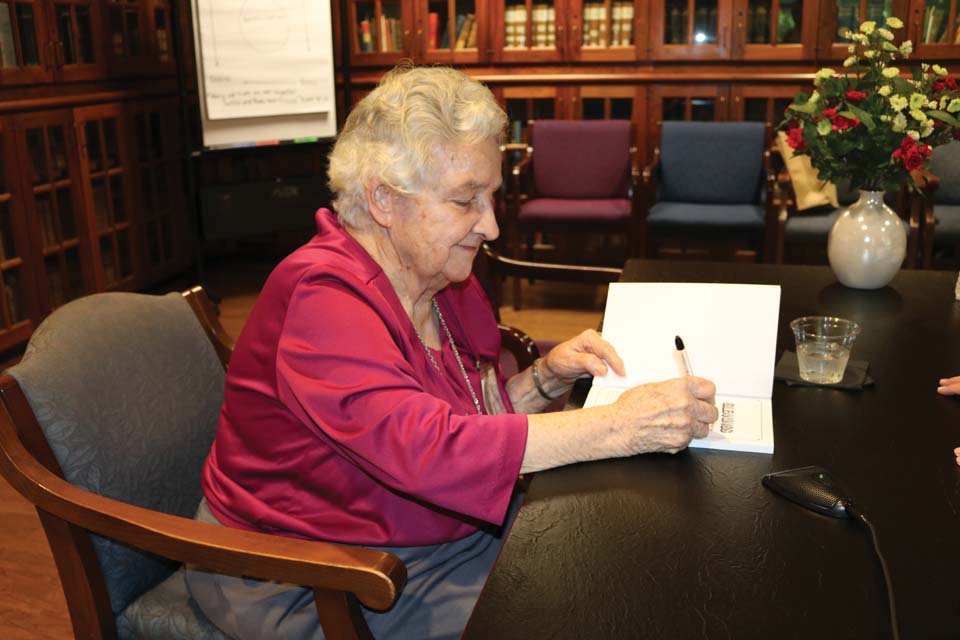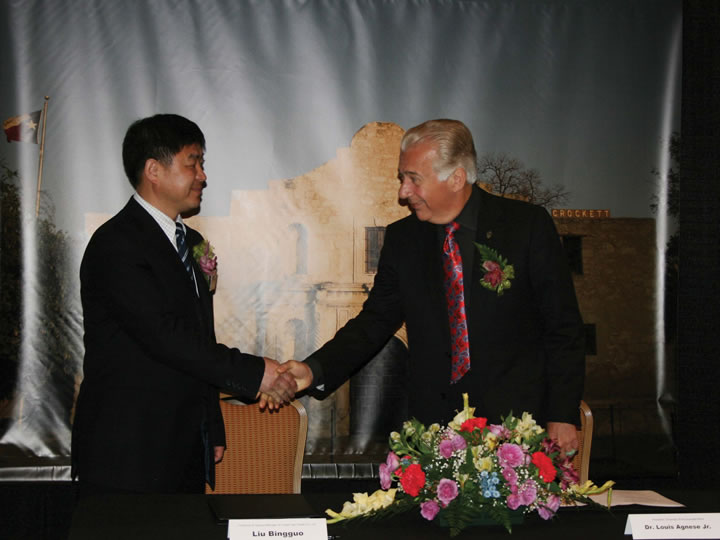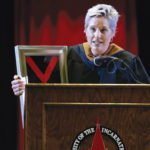Nursing building renovation and expansion will accommodate 50 percent more students
By Ashley Festa

Vladimira and John Miller joined the dedication of the Ila Faye Miller School of Nursing and Health Professions.
UIW nursing students now have a brighter and much bigger place to call home after a $6 million upgrade to the 40-year-old building that houses the School of Nursing and Health Professions.
“We couldn’t expand the nursing program because of the limited lab space,” said Dr. Kathi Light ’70 BSN, dean of the nursing school. “There was room for only 10 students in the lab at a time.”
Working in the labs is especially important for nursing students because of the lack of control over clinical education in a hospital setting, which is unpredictable. With a laboratory, faculty can simulate specific situations, and students have a much more standardized experience.
In the old building, there was simply no room to upgrade the students’ lab experience. In addition, the building’s classrooms, with the exception of the one lecture hall, were limited to accommodating a maximum of 40 students per class.
At a time when the federal government was pressuring nursing schools around the country to increase enrollment to combat the shortage of nurses, UIW was bursting at the seams. The school had already launched a campaign to recruit new students and take enrollment from 25 students to 40 per semester, so classrooms were full.
On top of enrollment demands, government also pushed for improved graduation rates. So UIW focused on student retention, and eventually “we had no place to put them,” Light said.
UIW President Dr. Louis Agnese had been aware of the university’s need for more spacious accommodations if UIW were going to help satisfy the national shortage. So in 2007, a capital campaign began to raise the funds for expansion. With the support of friends and donors, the university was able to finance plans to renovate the existing building and add a third floor, a project that would cost $6.3 million, according to Sr. Kathleen Coughlin, CCVI, vice president for Institutional Advancement. Faculty and leadership in the nursing school collaborated to determine the building’s interior requirements.
“I put together a group of faculty, and we met regularly with the architect and with the facilities people here on campus,” Light said. “And we talked about what we wanted to have happen for our students.”
On May 1, 2010, just as they were finishing their final exams, students and faculty were ushered out of the old building for renovations to officially begin. In an effort to make-do for the fall semester, nursing faculty taught classes at the Datapoint ADCaP location. The Baptist School of Health Professions generously allowed UIW students to use their laboratory facilities while construction progressed on the main campus.
Light’s favorite gift of 2010 was the set of keys she received on Christmas Eve – keys to the freshly painted, three-story, fully equipped and updated nursing school building that she could again call home. Bright and early on Jan. 3, faculty started moving back in.
Only two weeks later, more than 300 people gathered outside the updated building to celebrate the dedication of the Ila Faye Miller School of Nursing and Health Professions. Ila Faye was a nurse herself and a supporter of Incarnate Word way back in the 1920s. Her son, John Miller, a member of UIW’s Board of Trustees, and his wife, Vladimira, a UIW alumna, contributed a major gift to the capital campaign in memory of Ila Faye.
During the ceremony, Miller explained to the crowd how his mother had taught him how to treat people and how to make a living. He said he felt proud to be able to contribute to the education of other nurses and to Incarnate Word.
 Senior nursing major Caroline Heileson, president of the UIW Student Nurses Association, feels thankful for the Millers’ generosity, and she’s thrilled with the results.
Senior nursing major Caroline Heileson, president of the UIW Student Nurses Association, feels thankful for the Millers’ generosity, and she’s thrilled with the results.
In addition to the face lift, which she thinks makes the building “feel homier and more welcoming,” the school’s classrooms and labs now provide students more space to work and study.
“The new kids are really getting spoiled,” she joked.
The updated building now has an elevator large enough to fit a stretcher, and there are electrical outlets at every seat in the lecture hall. Instead of just one small demo lab, the school now offers two large all-purpose labs and also several smaller labs dedicated for specific purposes. For example, there are rooms designed as an intensive care unit, a medical surgical lab, a maternity lab and a community health lab, which replicates a home setting where students learn to provide hospice visits. High fidelity mannequins in each lab can be controlled and made to cry, cough, talk and breathe, which provides a more realistic setting to practice healthcare.
Heileson praised the addition of a control room, where faculty members are separated from students working on patients. Instead of a professor looking over students’ shoulders, which was necessary with the old setup, the caregivers are now left alone to make independent judgment calls as faculty watch on video from another room. Later students are graded on their performance. This arrangement provides a more relaxed and productive practice area for students, Heileson said.
In the debriefing lab, faculty members can show a video of students’ work and point out what went well and what needs improvement. Students can rewind the recording to review their work and ask questions about particular aspects of their performance. Before the upgrade, simulation labs were available only at off-campus facilities.
“I’m proud to say this is my school,” Heileson said.
Maria Gillespie, a faculty member in the nursing school, and her husband, Michael, wanted to do something special for the renovation. They decided to donate artwork that would depict the history of nursing at Incarnate Word, beginning with the Sisters’ ministry started in 1869 when they arrived in San Antonio to treat victims of cholera. The couple commissioned Brother Cletus Behlmann for the three pieces that now hang in the Kelso Conference Room and the fourth piece in the fourth floor student common area.
With a new facility comes the need for more faculty members. And with the help of grants from the Texas Higher Education Coordinating Board, which awards funds to schools that increase graduation rates, the nursing school has been able to hire several new faculty members already. Light would like to hire several more to accommodate the growing recruitment. The construction will allow an increase in enrollment of up to 50 percent.









